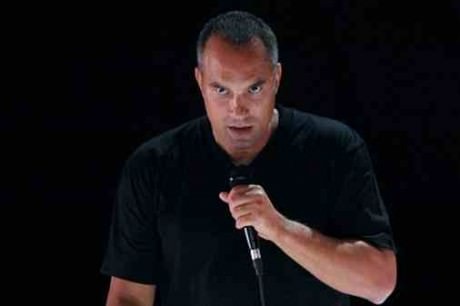If ever there was an Inadvertent American Hero, it’s Rodney King, the black construction worker whose brutal beating in 1991 by white cops in LA, caught on videotape, appalled the world, indicted a nation’s racism, and galvanized a community’s outrage. Roger Guenveur Smith, the creator and virtuoso performer of the solo theater piece Rodney King now playing at Woolly Mammoth, calls King “the first reality TV star.”

King’s eloquently simple “Can’t we all get along?” speech instantly became a catchphrase for the conscience of a country caught with blood on its hands. The name Rodney King itself became a Super Symbol; one merely need drop it, in a clucking conversation or commentary, to evoke a sprawling historical narrative filled race hate and victimization without going into unpleasant details. Other personages in other circumstances have risen to such prominence and placeholder recognition. They live on like flat faces in the stacked deck with which pundits play “the race card,” their names invoked with meta-meaning even as their actual lives as real individuals go obscured and ignored. Think Emmett Till. Or Trayvon Martin.
What happens is that we project onto such a particular person what we want and need them to stand for. What we want and need them to mean. What we want and need them be the generic for. (And in the process, the “we” in those sentences becomes a cohesive aggregate as well; depending on what you project onto such an iconic individual, you join the “we” with which that symbology is shared.)
What’s so powerful about what Smith does onstage in front of a live audience is is that he brings Rodney King to life…by projecting Rodney King onto us.
Smith never refers to Rodney King in the first or third person. That in itself is disarming, given that the show purports to be autobiographical. Instead Smith tells King’s story as if to King himself, speaking in the second person. “Right, Rodney?” Smith interjects throughout, like a refrain, to remind us that Smith is telling us about King by always talking to him. The uncanny incremental effect of this device is that Smith tells the story as if the audience is King.
Rodney King invites us—through Smith’s poetic gifts and extraordinary physical and vocal command of the stage as an actor—to identify with the real person Rodney King, to get inside what it was like to live his real life…or not. Because Smith always leaves that esthetic/ethical choice up to us: Do we experience this man’s story as one we’re more comfortable holding at arm’s length (perceiving it as if through a Brechtian alienation lens, because we ourselves are unlikely to be on the receiving end of a racist bludgeoning)? Or do we experience this man’s story as one to which we can relate (because that likelihood is always lurking for us or those about whom we care).
As theater craft, Rodney King is a stroke of genius. As a tribute to an accidental martyr, it is moving beyond words. As a humbling and humanizing collective experience, it must be seen and heard while you and we have the chance.
Running Time: Approximately one hour, with no intermission.
Rodney King plays through July 9-20, 2014 at Woolly Mammoth Theatre Company — 641 D Street NW, in Washington, D.C. For tickets, call the box office at (202) 393-3939, or purchase them online.
LINKS
Roger Guenveur Smith’s website.
An excerpt from his monologue Rodney King.
The Playwright’s Playground-Unscripted and Improvised-Roger Guenveur Smith Discusses His Solo Performance of ‘Rodney King’ at Woolly Mammoth Theatre Company by Sydney-Chanele Dawkins.
Cinema Speak with Sydney-Chanele: ‘Unscripted and Improvised – Roger Guenveur Smith, Discusses Making Movies & His Unparalleled Collaboration with Spike Lee’ by Sydney-Chanele Dawkins.





